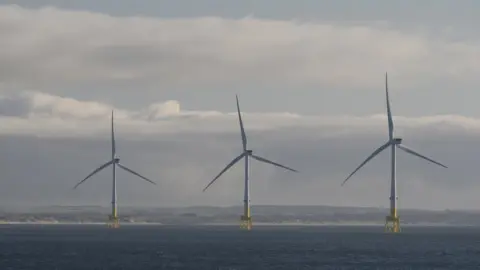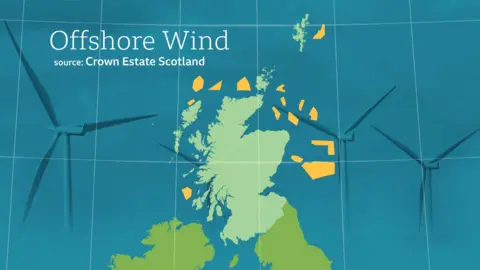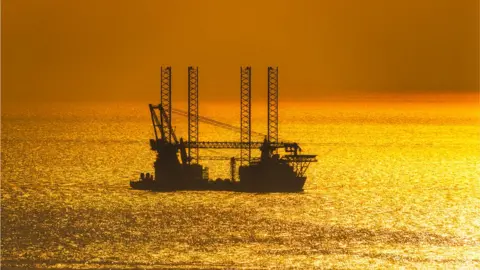Windfall: offshore power draws big players

 Getty Images
Getty Images- An auction for the right to develop Scottish sea areas for 10 gigawatts of power could net government more than £850m.
- Oil companies and institutional investors are piling into greener energy, joining forces with those who have experience of it.
- One challenge after today's bidding deadline is to capture benefit for Scottish firms and jobs.

It feels like a good week for solar power, but wind is having its place in the sun as well.
On Friday at 5pm, bids are due to be lodged for the right to develop 10 gigawattts of power in Scottish sea areas that are being newly released for development.
How to measure that scale? So far, Scotland has less than one gigawatt in operation, much of that in test sites and an older array in the Solway Firth.
It has more than 6 gigawatts in the development pipeline for the North Sea. To add 10 gigawatts would, by industry calculations and so long as the wind blows, power seven million British homes. That's nearly quarter of all British homes and more than double Scotland's total.
Alternatively, it could be used to power industry and crack the molecules that will create hydrogen power for heavy transport and perhaps heating. Here's what you might want to know, with some background.
Why are we talking about the next generation, when the current one hasn't been built?
That's an easy one. These projects take time: identify suitable bits of sea, without too much hazard for marine life or shipping: then auction the right to develop that, starting a long, technical process of securing permissions, designing the project including its subsea cabling and links to the grid, getting in place the billions of pounds required, placing orders and getting on with installation.

With Beatrice, to the east of Caithness, the only big wind farm in operation in Scottish waters, we're now seeing significant activity in preparing the seabed for a large array close to the East Neuk of Fife, plus the subsea cabling.
Next will be wind arrays off the Aberdeenshire and Angus coast. The generation begun nearly 10 years ago will begin to appear on the horizon before long.
Isn't England ahead of Scotland on offshore wind power, and why is that?
Britain is leading the world - not in the technology or manufacturing, much of which is imported - but in developments in the North Sea. The southern North Sea has advantages of being shallower, so it's easier to plant your wind turbine on the seabed.
It's cheaper also to connect to the grid if it's further south, which is the source of some controversy about the disadvantage faced in Scotland.
Where Scotland has an advantage is that it's got more consistent, higher wind speeds out at sea.
The cost of developing per megawatt has fallen very sharply in recent years, making it technically and financially viable to develop in these more expensive areas of the North Sea, and into the Atlantic.
What does ScotWind involve?
This is an auction of the right to develop several sites chosen by Marine Scotland, part of the Scottish government. The process is managed by Crown Estate Scotland, which takes its lead from the Scottish government and it pays its profits there, as of four years ago, when it was devolved.
The sites are on a much bigger scale than before: 8,600 square kilometres, in 15 zones of Scottish sea: the biggest well to the east of Montrose, with several new big areas in the outer Moray Firth: one east of Shetland, three to the west of Orkney: a zone to the north-west of the isle of Lewis, and north-west of Islay.
The sea off Islay was considered before, but that plan was abandoned because the rock on the seabed is very tough for drilling, and they discovered there were far more basking sharks than they previously thought. It was decided that drilling piles for turbine platforms would upset them.
ScotWind will feature several floating wind arrays, being pioneered in Hywind, the world's first floating wind farm off Aberdeenshire.
These are anchored to the seabed, and make it possible to put turbines into much deeper water or where piles cannot be installed.
How does the auction work, and what could it raise?
It's nearly a conventional auction: here's the right to develop, and here are the terms and conditions attached: how much will you pay?
In England, they ran a similar process earlier this year, and both industry and government were astonished at how much firms were willing to pay to get the right to develop these sites.
 Crown Estate Scotland
Crown Estate ScotlandThe ScotWind auction was due to take place soon after that, but it was halted when they realised that the cap placed on Scottish bids was too low.
That cap (not used in England) is intended to make it more attractive for more companies to get involved, to ensure the right pipeline of projects rather than just the most lucrative, and - they hope - that can help ensure more of the value in the supply chain is captured by Scottish firms - another very controversial issue with the current crop of wind farms.
So Crown Estate Scotland raised the cap for the auction bids being submitted today, by ten-fold, to £100,000 per square kilometre.
How much could that raise? If every bid is submitted up to that maximum cap, it could raise £860m. It's unlikely they'll get all that, but they should get a sizeable chunk of it. And that's money that flows to the Scottish government from the private companies winning the right to develop.
Once they start operating, Crown Estate Scotland will charge leasing fees, so more money will flow into the public purse.
What has been seen as a very heavily subsidised sector is now turning into a cash cow for government, and it brings a lot of jobs in installation, then in operations and maintenance. Maybe also in manufacturing.
How many turbines will this mean?
Thousands. But the total depends on the efficiency of the turbines of the 2030s. A big turbine used to be rated 1.5 megawatts. At more than 200 metres in height, they're now heading up to 10 times that much.
Wind farms are typically being built with fewer but bigger turbines than originally foreseen.
Who's doing the bidding?
Some of the companies have gone public with their bids, to show they are serious players in this sector.
They are typically in consortia, including those with deep pockets and much smaller companies with expertise in taking wind farms to the point where the billions are required.
 Westend61
Westend61The bigger players include big investment funds in green energy, like Australia's Macquarie Bank. The big utility companies are involved, as they are in existing projects, including SSE and Scottish Power.
Big oil companies have turbocharged these auctions, eager to balance their hydrocarbons with green energy. Bids are expected from BP, Total from France, ENI from Italy, Equinor from Norway, and Shell is bidding alongside Scottish Power to get into floating wind turbines.
We should be told some time next week how many bids have been submitted. After appraisal of the bids by Crown Estate Scotland, we should find out early next year which have been successful and how much they are paying.
